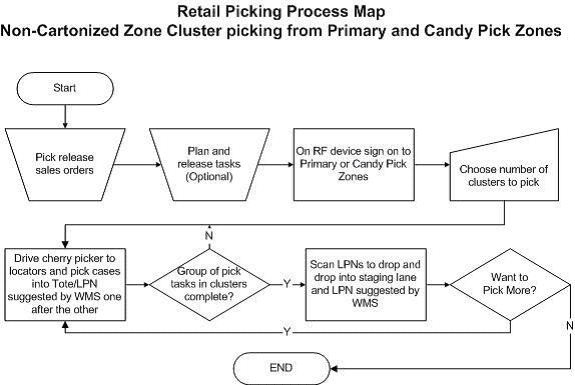Warehouse Management Case Study
This appendix covers the following topics:
- Overview
- Inbound Process
- Outbound Process
- Retail Picking:
- Replenishment
- Accuracy and Counting
- Major Challenges
- Facility Map
- Sample As-Is Process Maps
- Using Warehouse Management in Conjunction with Business Process Re-engineering to Address Current Challenges
- Sample Warehouse to be Process Maps
Overview
Beanz n' Leavz (B&L) is the world leader in the specialty coffee industry. B&L sources whole beans from the best coffee plantations in the world and roasts them using patented roasting technology. The company sells whole bean and ground coffee along with freshly brewed espresso style beverages, cookies, pastries, candy and allied accessories and equipment via its numerous retail stores throughout the world. B&L also sells tea products and their flagship bottled coffee drink Beanzo by exclusively partnering with niche suppliers. In addition to sales through its company-operated retail stores, B&L sells whole bean coffee and specialty items online through B&L.com and to special customers such as supermarkets and hotels. B&L's vision is to establish itself as the most recognized and respected brand in the world. The company plans to achieve its vision by rapidly expanding its retail operations, growing its specialty business and introducing new products.
B&L has approximately $2.5 Billion in annual revenue and has two distribution centers, one located in Memphis, Tennessee and the other in Irvine, California. The business is rapidly growing at the rate of approximately 1000 new retail stores a year. Revenues are growing at 20% a year and operating income by 30% a year. Recently, B&L has decided to replace its paper-based Warehouse Management System (WMS) and implement the Oracle Warehouse Management System in its Memphis facility. The company has brought in a team of consultants to analyze the operations, propose an implementation plan and recommend how the new warehouse management can increase throughput.
The following information pertains to the Memphis facility only.
Application Landscape
B&L uses the following applications for their various operations:
-
Retail, International, Interplant – DistributeX
-
Online – Amadeus OM, DistributeX and X-Ship
-
Super markets, Hotels – Picasso OM, DistributeX and X-Ship
Product Profile
B&L has the following product profile:
-
15000 SKUs
-
9000 Active SKUs, some lot/expiration controlled
-
General product mix:
-
Ground Coffee (3 pack sizes),
-
Whole Beans (3 pack sizes),
-
Tea (2 pack sizes),
-
Beanzo bottled drinks,
-
Confections and Candy,
-
Coffee makers,
-
Espresso machines,
-
Cups,
-
Syrups,
-
A large variety of specialty items such as mugs, CDs, T-Shirts,
-
Store setup items such as tables, chairs, product tags etc.
-
Customer Profile
Retail
B&L Outlets 4000 worldwide, growing at the rate of 1000 a year. B&L Memphis services 2000 outlets and 600 new stores a year.
Online customers:
-
5000 to 8000 Orders per day (90% single, 100% piece picks)
Super Markets, Hotels:
-
200 – 300 orders per day, 3000 to 4000 pieces per day
-
B&L Pennsylvania caters to customers in the Midwest, North East and South of the US and all International Orders
Vendor Profile
B&L receives material from the following:
-
Roasted Ground and Whole Bean coffee from the adjacent production plant
-
Most specialty items from China
-
Paper Cups, CDs, Tables, and Chairs etc. from US vendors
-
Tea from partners
Shipments comprising any of the above from the other facility in Irvine
Inbound Process
General Merchandise and Non-Green Coffee receiving is performed via the 6 inbound dock doors. A unload, stage, and check in process is utilized. Purchase order is used for merchandise check in. Inbound shipments are scheduled by appointments over two shifts. A color coded pallet ticket is applied to loads. Receipt quantity is shown on receiver. Expiration code date is entered when available. Inbound staging lane space is highly utilized on first shift.
Receipts are put away on a first come basis. Material is always received and putaway in full pallets. Pallets are put away one pallet at a time. An attempt is made to put away product in the primary pick location but high space utilization causes product to be put away in a random manner.
Production coffee is staged in the Production Staging Area. Production inventory is updated in the DistributeX system 3-4 times per shift. Production inventory is not reconciled between production and the warehouse.
Only visibly damaged material or non-compliant pallets are sent to the rework area. In the re-work area 3-4 people correct vendor errors and prepare product for putaway. Vendors are charged back for non-compliance. This information is kept track in a spreadsheet and sent to vendors twice a month.
Outbound Process
The Outbound process can be divided into the following:
Retail Picking:
-
Ten to twelve waves are handled over two shifts
-
Twenty to forty thousand units are picked over two shifts
-
Orders are processed on the DistributeX System
-
Pick zones consist of Candy, Overstock, Primary and Case Flow (Promotion)
-
Pick to single orders. Pick tickets are printed and sorted by zone for each order.
-
One person picks entire order from all zones except Case Flow
-
Candy, Overstock and Primary picks are brought directly to staging lanes and consolidated on pallets.
-
Picks from Case flow are consolidated in the intermediate consolidation area and finally consolidated with others in the staging lane.
-
Consolidated pallets are stretch wrapped. Pallets are 7ft high.
-
Each store receives one shipment of 1-2 pallets per week with two shipments during Christmas. The second shipment is generally a small shipment.
-
There are 8 major promotions per year.
-
Space utilization is low on Case Flow
New Store Orders:
-
On an average has 1500 lines
-
Orders are processed on the DistributeX System
-
Pick to single orders. Pick tickets are printed and sorted by zone for each order.
-
One person picks entire order from all zones.
-
It takes 2-3 days to pick a complete order.
-
Staged in the New Store staging area.
-
Two store orders can occupy a truck load.
International Orders:
-
Same as retail and new store orders.
-
There are 100 international stores.
-
There is one new store order per month.
Online Customers:
-
Picked to order
-
Orders are processed on the Amadeus OM< DistributeX and X-Ship systems.
-
Printers sorts orders into pick zones; however, orders still have some manual sorting.
-
During peak season 5000-8000 orders are processed per day.
-
Gift orders create a flow problem during the busy season.
-
Space utilization is low on the pick belt.
-
The packaging operation is very labor intensive.
-
Shipment verification is a manual scan.
-
Product is transferred from retail to online as needed.
-
There are 8 packing stations.
-
Products are shipped using FedEx or UPS
Super Markets and Hotels:
-
200-300 orders per day
-
3000-4000 pieces picked per day
-
Orders are processed using Picasso OM, DistributeX and X-Ship
-
Picks from case flow only
-
It takes 4.5 hours to prepare order shipping paperwork
-
75% case pick
-
A shipment tracking bar code is applied to all cases via Pfast Ship
Replenishment
The DistributeX System generates a list of replenishments in advance of requirements for all of the above. Replenishment is performed from Overstock to Primary. Not all replenishments arrive at the primary locations before the pick is attempted.
Accuracy and Counting
-
Cycle coutning is performed on an as needed basis
-
Inventory accuracy is 85%
-
Average inventory level is $16M
-
Coffee turns are approximately 13.0 turns per year
-
Obsolete inventory is $1M
-
Duplicate SKUs between retail and online are being eliminiated
-
No ABC stratification
Major Challenges
B&L is facing substantial challenges in the following areas:
-
Maintaining information in three systems
-
Inventory accuracy is 85%
-
Annual Inventory obsolescence is $2 M
-
High Space Utilization of 90%
-
Overtime and Temps
-
Mis-shipments are $500,000 per year
-
Attempted implementing a Best-of Breed warehouse management and pulled the plug in a week due to a severe backlog (5% of pre go-live volume shipped per day)
B&L is currently not interested in replacing its existing production system.
Facility Map
The facility map is shown in the attached layout below. The warehouse is 300,000 sq. ft. and is attached to a production facility. It has 6 Inbound Dock Doors for general receiving and 14 Outbound Dock Doors for general shipping on one side of the building. It has one dock door on one side of the building separate from all other dock doors, catering to FedEx and UPS shipments. All Locators are labeled but not barcoded because operations are paper based.
Beanz n' Leavz
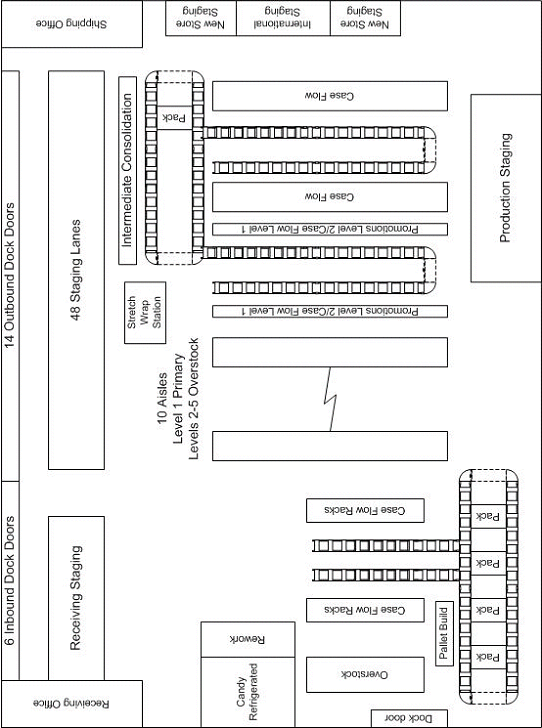
Sample As-Is Process Maps
The following section shows the sample "as-is" process maps for the company named Beanz nLeavz.
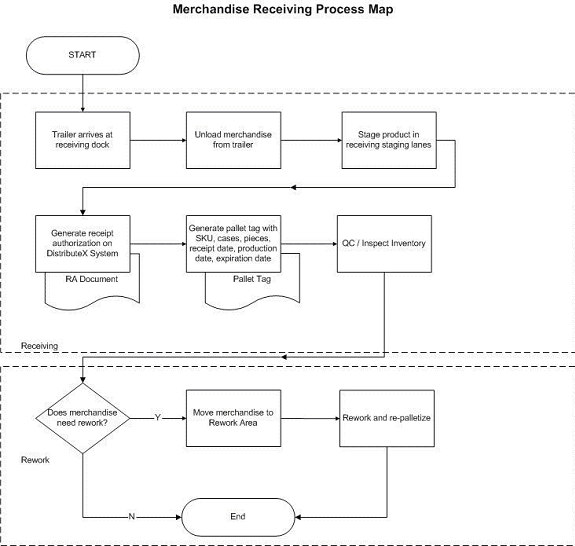
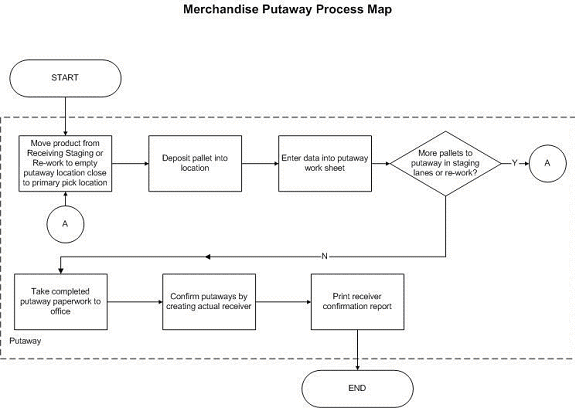
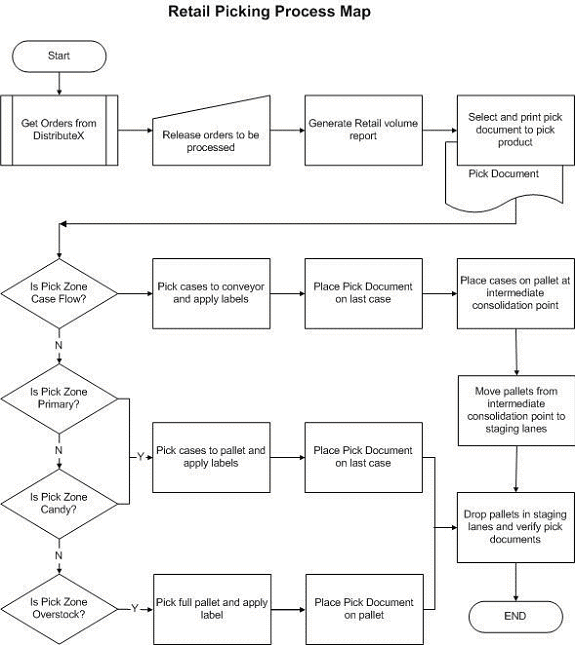


Using Warehouse Management in Conjunction with Business Process Re-engineering to Address Current Challenges
The following section discusses the challenges and the solutions for Beanz n' leaves.
Maintaining Information
Challenge
Beanz n' Leavz currently maintains in three separate systems.
Solution
The Oracle e-business suite is a fully integrated system that allows order entry and capture via multiple channels such as back-office call center order entry, web orders and order import. This multi-faceted solution should eliminate the current necessity to use multiple systems to capture orders. In addition, warehouse management negates the necessity to hold inventory information in multiple systems. Also, warehouse management is a real-time application in that the database is updated as and when a transaction is performed thereby maintaining currency of inventory information.
Inventory Accuracy
Challenge
Beanz n' Leavz inventory accuracy is currently 85%
Solution
As stated above, warehouse management is a real-time application in that the database is updated as and when a transaction is performed thereby maintaining currency of inventory which in turn will aid in using accurate data for material allocation. This will ensure that the pickers will indeed find material in the right locators when they perform picks. Currently, B&L uses a paper based system with minimal barcodes to perform transactions. Warehouse management thrives on using barcodes for a majority of its execution transactions. Barcodes eliminate errors, improve efficiency and augment the real-time nature of doing business.
Inventory Obsolescence
Challenge
Annual Inventory obsolescence is $2 Million
Solution
When inventory accuracy is increased, the inventory availability picture is current and accurate. This in conjunction with sophisticated material allocation rules via the warehouse management rules engine can ensure elimination of inventory obsolescence by allocating material long before expiry. In addition, system directed tasks in warehouse management will pin-point locators and material and direct users to retrieve and/or deposit material with tremendous accuracy and efficiency.
Space Utilization
Challenge
Beanz n' Leavz has a space utilization of 90%
Solution
This challenge can be addressed via a combination of business process re-engineering, layout changes and warehouse management.
Space utilization is currently low in the case flow area. The online picking process is similar to the case flow picking process but requires tremendous amount of space and labor. In addition, shortages in either the case flow or online picking areas are addressed by transferring merchandise from one to the other as appropriate. The key reasons behind having a separate online picking area are that the volume is high and the order entry/management systems employed is different.
By implementing the Oracle e-business suite, a single Order management system can be used to capture all kinds of orders. By implementing warehouse management and utilizing cartonization and pick and pass methodology, high volumes can be addressed.
By business process re engineering, the online order picking area can be eliminated and consolidated with the case flow area. This in turn will free up all the space used for online picking thereby reducing the space utilization and creating room to expand throughput.
The intermediate consolidation step can be totally eliminated by re engineering the business process via better pick release planning and consolidation.
Personnel
Challenge
Use of temps and overtime for employees
Solution
The re-engineering and elimination of the current online order picking process will allow for reassignment of labor thereby eliminating the necessity to hire temps. The operational efficiency introduced by warehouse management will eliminate the necessity for overtime.
Mis-Shipments
Challenge
Mis-shipments is $500,00per year.
Solution
The current system is entirely paper based with minimal barcoding at the time of shipment. By the time picks are performed and are ready to be shipped, it becomes impossible to accurately determine if the shipments contain the required merchandise.
Warehouse management can increase picking accuracy up to 99.9% via barcodes and system directed picking. If picks are accurate, shipments will be accurate. Quality at the source will ensure quality of the end result. It will also eliminate packing and shipment verification thereby enhancing the overall efficiency of order fulfillment.
Best-of-Breed Attempted Implementation
Challenge
Attempted implementing a Best-of-Breed WMS and pulled the plug in a week due to severe backlog (5% of pre go-live volume shipped per day)
Solution
The Best-of-Breed warehouse management system would have provided operational efficiencies but would not have been able to address order entry/import into a single system. Consequently, it would not have been able to aid in re engineering the business process to consolidate the online order picking process with the case flow picking process. In addition, it is extremely vital that the implementation team understands the current business process and recommends the optimal business process that should be adopted when using the new system without sacrificing operational efficiency and/or accuracy.
The above warrants a strong implementation team that has a sound understanding of analyzing warehousing processes, recommending best practices and most importantly implementing warehouse management.
Sample Warehouse to be Process Maps
The following section shows the sample "to-be" process maps for the company named Beanz nLeavz using Oracle Warehouse Management.

